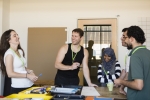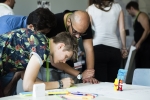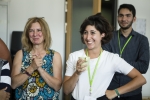
|
My journey of familiarizing myself with Design Thinking started in September 2010 during a study trip with HTW Berlin, University of Applied Sciences, to the “d.school. Hasso Plattner Institute of Design” at Stanford University. At this time, I served as lecturer for Business Ethics and Project Management. At the d.school we participated in a guided tour around the amazingly well-equipped rooms of the school and enjoyed a talk with one of the lecturers there. I was deeply impressed by the way they are dealing with students at the d.school, especially how they are giving the students the opportunity to build rough prototypes with different materials to visualize innovative ideas as soon as possible to the audience. |
|
|
Next, I bought all the books I could get about this innovation method. Being back in Berlin, I conducted plenty of online research on Design Thinking. David Kelley, Valerie Casey, Tim Brown from IDEO and lots of others became my digital teachers. For David Kelley Design Thinking is like a religion and everyone should use it. Besides the work of these persons, Design Thinking has many different roots in the fields of architecture and participatory design. See more: Design Things and Design Thinking: Contemporary Participatory Design Challenges. Erling Bjoegvinsson, Pelle Ehn, Per-Anders Hillgren. 2012 Massachusetts Institute of Technology. Design Issues: Volume 28, Number 3 Summer 2012. |
|
|
Furthermore, Design Thinking is increasingly being applied in classes, schools, universities, companies and institutions all around the world. In October 2010, I started my first course at HTW Berlin and asked the students to look for something they want to develop. This might not be the easiest method to build a model for a new product in just 32 hours. However, it was exciting to form a group of innovators all following the challenge brought up by a student: “How can we develop a toy, which generates electricity for the project “One laptop per each child” in Peru where schools often do not have electricity to run the laptops?”
SEE MORE ABOUT THE PROJECT
Until now my students have developed several prototypes and strategies for different cases always following the six steps of the human centered Design Thinking process: Understand – Observe – Point of View – Ideate – Prototype – Test. How can we develop learning labs for the future, innovative supermarkets, more customers for the public transport in Berlin, open design cities for locals…?
SEE MORE ABOUT THE CHALLENGES
|
|
|
Besides my profession as a lecturer, I have worked with companies and institutions to train their employees in Design Thinking and Human Values. What sets me apart as a lecturer and coach, is that I combine Design Thinking with Business Ethics. This entails always asking which human value the product, service or strategy will have for the company and for society. Therefore, I call it “Design Thinking and Human Values”. I am convinced that Design Thinking helps people to innovate products, services and strategies routinely, and that you can use the method for everything, just like David Kelley has proposed. Many companies including, Bosch, P & G, SAP, BMW, Telecom, DB, and BSR use this innovation method. These companies strive to advance their projects by using creativity, empathy and the energetic flow of a group working on a challenge within a short time period. Working with passion and dealing with a project that “goes under your skin“, (Tim Brown) creates the basis for a successful outcome. |
|

|
In spring 2016, I started working with refugees and migrants in my Design Thinking classes. Born myself as a daughter of a refugee who had to leave his home as a child during the Second World War I realized very early on how hard it is to feel accepted in another part of the world. If they cannot deal with their negative experiences from the war, it seems impossible for them to become resilient and selfconfident. In our classes, we could observe that Design Thinking helps all participants to discover their skills and creativity and regain their selfconfidence, especially so by building models for an innovative product within an intercultural and interdisciplinary group.
Author: Heike Ernst, Founder of ROOTPACKER
SEE THE REPORT ABOUT OUR REFUGEE SUMMER SCHOOL
|
|

NETWORK
 |
Heike Ernst
Founder of ROOTPACKER
Coach & Lecturer |
|
 |
Camilla Rackelmann
Communication Design, B.A.
Photographer |
|
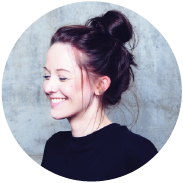 |
Anne Freude
Communication Design, B.A.
Marketing Strategy |
|
 |
Shahanaz Akter
International Business, MS |
|
 |
Hannah-Sophie Wahle
Refugee Rights Data Project
Kiron Open Higher Education
The London School
of Economics, MSc |
|
 |
Laura Haehnlein
Politics, Administration and
Organisation, B. A. |
|
 |
Seulki Lee
Communication Design, B.A. |
|
 |
Reza Abdi
Industrial Engineering, B.A.
Business Administration, MS |
|
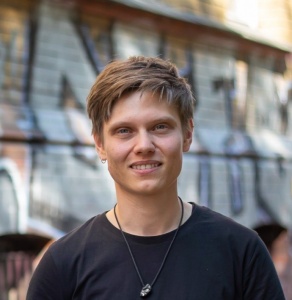 |
Ari Stoeppler
Communication Design, B.A. |
|
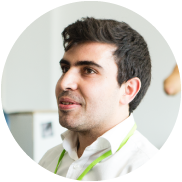 |
Tarek Alkhateeb
Civil Engineer
Urban Management MS |
|
LEARN MORE ABOUT OUT CURRENT SEMINARS




